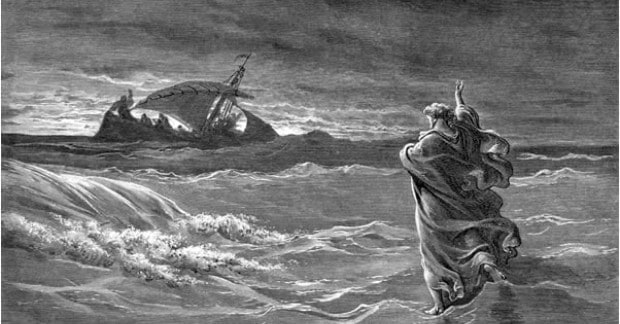Tales of tempests battering ships inspire respect for the sea. En route to Capernaum, Jesus’ disciples watched these stories become reality as the roaring wind transformed the waters around them. As they fought against the waves and wind, they witnessed a miracle: “They saw Jesus walking on the sea and coming near the boat” (John 6:19).
Appearing in three of the four Gospels, this event inspires Sunday school lessons and has become ingrained in our portrait of Jesus’ life. As spectacular and unforgettable as the event is to us, however, a Jewish audience would have seen in it a profound theological meaning against the backdrop of the Old Testament.
An Old Testament Symbol
In the Old Testament, the unpredictable sea is a common symbol of cosmic disorder—conditions contrary to God’s design for an ordered world. This symbol for cosmic anarchy is also personified as a sea monster, known as Leviathan or Rahab. The image of chaos as an untamed monster in a churning, erratic sea was common throughout the ancient world. People accustomed to land would naturally view the vast, raging ocean as uncontrollable and potentially deadly, filled with terrifying unknown creatures.
Religions across the ancient Mediterranean often depicted their important deities destroying or subduing the sea dragon, thereby calming the sea and restoring order. In the Old Testament, it is Yahweh, the God of Israel, who conquers the forces of chaos and imposes order in the cosmos (Job 26:12–13; Psa 89:5–14). This imagery is applied even to the exodus from Egypt (Psa 74:12–17), where God split the sea to deliver his people, thereby conquering the forces of evil that sought their demise.
Final Victory
God’s ultimate victory at the end of the age is also depicted as God dominating the forces of the sea: “In that day the Lord with his hard and great and strong sword will punish Leviathan the twisting serpent, Leviathan the crooked serpent, and he will slay the dragon that is in the sea” (Isa 27:1). This is why the description of the final paradise of the new heaven and new earth contains the phrase, “the sea was no more” (Rev 21:1).
The prophet Daniel’s vision of the end of days and the kingdom of God includes four beasts that emerge out of a storm-tossed sea (Dan 7:1–8). These beasts are not aquatic creatures by nature. They come from the sea because they represent chaos. God’s heavenly court sentences the beasts to death (Dan 7:9–12), after which the “son of man” arrives immediately to receive the kingdom of God (Dan 7:13–14). All of this imagery informs John’s account of Jesus walking on the sea during the storm.
Jesus Christ, Lord over the Sea
John identifies Jesus as the Son of Man to whom the Father has given the authority to execute judgment (John 5:27; compare Matt 26:57–68). John also asserts repeatedly that Jesus is God incarnate. In John’s Gospel, Jesus invokes the divine name (“I AM”) seven times in reference to himself (e.g., John 6:35; 15:1). He declares oneness with the Father (John 10:30), and he proclaims that the Father is in him and he is in the Father (John 10:37–38).
For John, a Jew familiar with the Old Testament, the image of Jesus walking on the sea was a dramatic portrayal that Jesus is Yahweh—the one who subdues the forces of chaos and imposes his will on the waters and everything the waters represent. The kingdom of the Son of Man had begun, and all forces opposing God’s ordained order would now be defeated. Like Jesus’ disciples, we can find comfort in knowing that the one who treads upon the volatile sea can subdue whatever chaos threatens to overwhelm us.
QUICKBIT: The three accounts of Jesus walking on water are found in John 6:16–21, Matthew 14:22–33 and Mark 6:45–52—the Gospels authored by Jewish writers. Luke doesn’t include this detail, likely because he was a gentile writing to a gentile friend, Theophilus (Luke 1:1–4).
***

This article is excerpted from Dr. Heiser’s book I Dare You Not to Bore Me with the Bible.
Discover more fascinating aspects of the Bible with Dr. Heiser
Keep exploring the strange, perplexing, and mysterious aspects of the Bible with these excerpts from Dr. Michael S. Heiser’s The Unseen Realm: Recovering the Supernatural Worldview of the Bible. Or dive deeper into the supernatural world of the Bible and pick up a copy of The Unseen Realm today.





